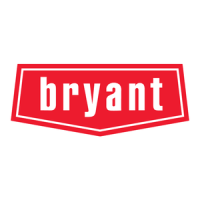
Do you have a question about the Bryant ERVBBSVA1100 and is the answer not in the manual?
Identifies hazards from mechanical/electrical components, emphasizes qualified personnel, safety codes, and signal word meanings.
Explains the unit's function in exchanging indoor stale air with fresh outdoor air using a cross-flow core for heat transfer.
Guides on inspecting the unit for damage after unpacking and selecting an appropriate installation location for accessibility and performance.
Details methods for mounting the unit, including suspension from floor joists or installation on a shelf with vibration isolation.
Describes applying the ERV/HRV as a standalone unit with separate registers for fresh air supply and stale air return throughout the home.
Details integrating the ERV/HRV with existing forced-air systems, connecting supply and return to the ductwork for air exchange.
Instructions for connecting flexible ducts, insulating them, and setting up the condensate drain with a loop trap.
Guidance on locating and installing fresh-air intake and stale-air exhaust hoods, ensuring proper separation and height.
Lists available wall control options and recommends placing them in an area that monitors fresh air circulation.
Explains the humidity selector's function and recommends humidity levels to avoid condensation during different seasons.
Details the OneTouch control's ability to cycle through operation modes with button presses.
Details the use of 20-minute and 60-minute adjustable timers to override wall control for high-speed operation.
Step-by-step guide for balancing airflow using a magnehelic gauge and balancing dampers to ensure optimal system performance.
Instructions on adjusting fresh and exhaust air dampers and recording airflow information for future reference.
Provides guidelines and tables based on ASHRAE standards to determine the required airflow for a home based on area and bedrooms.
Explains the control board's operation for defrost cycles and various air exchange modes (Off, Intermittent, High-Speed, Low-Speed).
Covers cleaning and maintenance for filters, blower motor, energy recovery core, and unit door access.
Details how to perform override tests for high and low speed operation, and adjusting blower speed settings.
